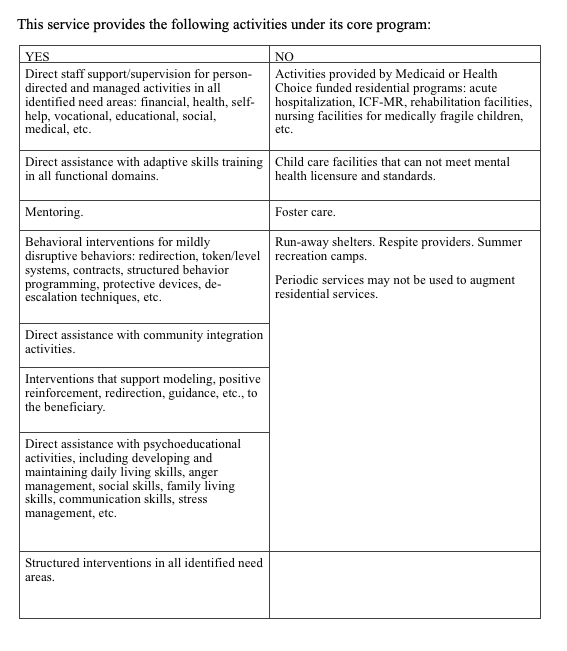
Level II Residential Facility Services
This service level is responsive to the need for intensive, interactive, therapeutic interventions, which still fall below the level of staff secure/24-hour supervision or secure treatment settings. The staffing structure may include family and program-type locations.
This service in the family settings includes the following activities:
Individualized and intensive supervision and structure of daily living designed to minimize the occurrence of behaviors related to functional deficits to ensure safety during the presentation of out-of-control behaviors or maintain an optimum functioning level.
Specific and individualized psycho-educational and therapeutic interventions, including:
-
development or maintenance of daily living skills;
-
anger management;
-
social skills;
-
family living skills;
-
communication skills;
-
stress management;
-
relationship support; or
-
comparable activity; and
-
intensive crisis or near crisis management, including de-escalation interventions and occasional physical restraints.
Direct and active interventions in assisting beneficiaries in the process of being involved, maintaining naturally occurring community support systems, and supporting the development of personal resources (assets, protective factors, etc.).
*Note: Periodic services may not be used to augment residential services.
The Level II Residential Group Home Service Type is a Residential Treatment Level II is a 24-hour service. The Family Type service is licensed under the Division of Social Services 131-D family setting homes. The program Type service is also licensed under the Division of Health Service Regulation 122-C for residential treatment.
The Peace In The City Resiliency/Environmental Intervention is to support the youth in gaining the skills necessary to step down to a lower level of care. The service delivery setting is a Family type and Group home.
Medical Necessity must be met to gain admission into the program. In addition to meeting Family Type Residential Treatment Level I medical necessity criteria, the beneficiary is eligible for this service when:
Medically stable but may need some intervention to comply with medical treatment. The beneficiary's identified needs cannot be met with the Family Type Residential Treatment Level I services.
The beneficiary is experiencing any one of the following (may be related to the presence of moderate to severe affective, cognitive or behavioral problems or intellectual/developmental delays/disabilities):
-
Moderate to severe difficulty maintaining in the naturally available family or lower level
-
treatment setting as evidenced by, but not limited to:
-
severe conflict in the setting; OR
-
severely limited acceptance of behavioral expectations and other structure; OR
-
severely limited involvement in support; OR
-
impaired ability to form trusting relationships with caretakers; OR
-
Limited ability to consider the effect of inappropriate personal conduct on others.
-
Frequent and severely disruptive verbal aggression. Regular and moderate property damage. Occasional and mild aggression toward self or others.
-
Moderate to severe functional problems in school or vocational setting or other community settings as evidenced by:
-
failure in school or vocational setting; OR
-
frequent and disruptive behavioral problems in school or vocational environment; OR
-
frequent and disruptive difficulty in maintaining appropriate conduct in a community setting; OR
-
4. pervasive inability to accept age-appropriate direction and supervision, in significant areas, from caretakers or family members.
-
Medication administration and monitoring have alleviated some symptoms, but other treatment interventions are needed to control moderate symptoms.
-
Having limitations in the ability to access or participate in other human services independently. Requiring active support and supervision to stay involved in other services.
-
Deficits inability to manage personal health, welfare, and safety without intense support and supervision.
-
For beneficiaries identified with or at risk for inappropriate sexual behavior:
-
at least one (1) incident of inappropriate sexual behavior and the risk for offending/re-offending is low to moderate; OR
-
low to moderate risk for sexual victimizing; OR
-
Deficits that put the community at risk unless specifically treated for sexual aggression problems.
-
A Sex Offender Specific Evaluation (SOSE shall be provided by a trained professional, and a level of risk shall be established (low, moderate, high) using the Risk Checklist for Sexual Offenders, the Juvenile Sexual Offender Decision Criteria, and a Checklist for Risk Assessment of Adolescent Sex Offenders.
